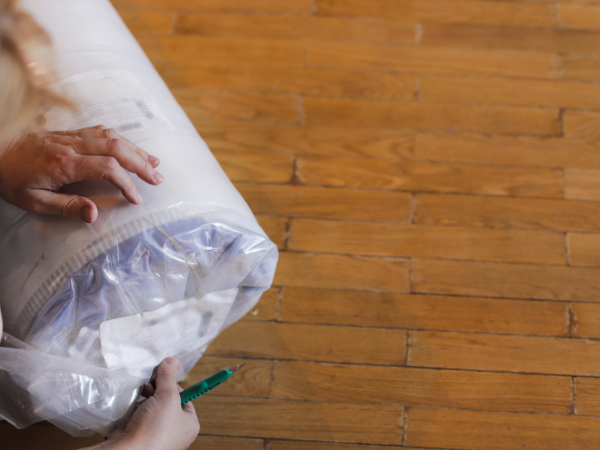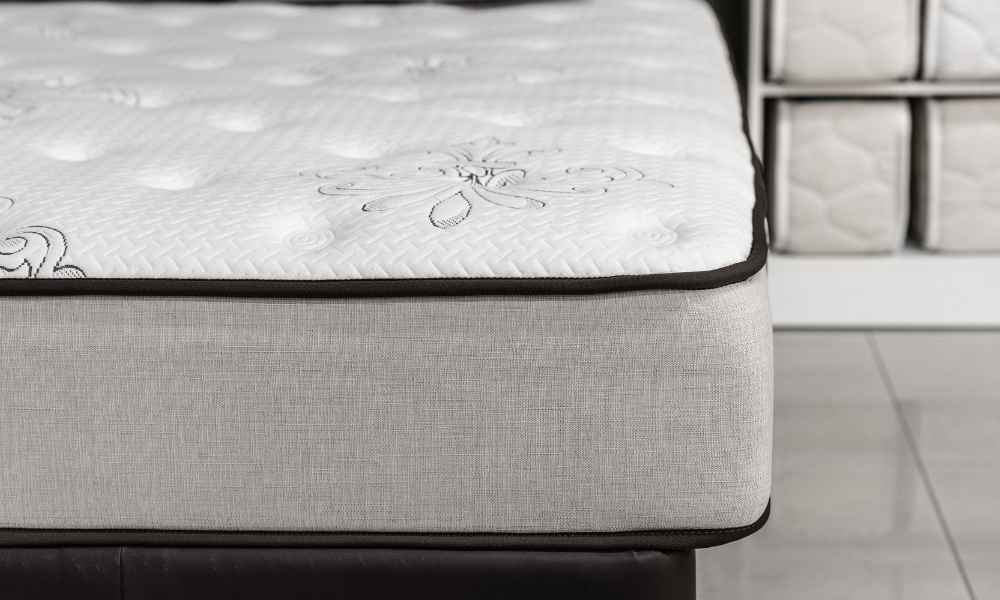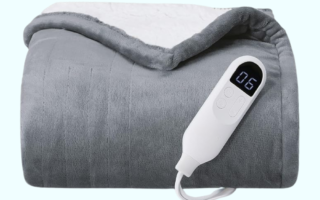A mattress can stay vacuum sealed for 6 months to 1 year. Proper storage conditions are essential for prolonging its lifespan.
Storing a mattress for an extended period requires careful consideration. Moisture, temperature, and storage location play crucial roles. Ensuring the mattress is clean and dry before vacuum sealing can prevent mold and mildew growth. Use a high-quality vacuum-sealing bag to maintain the mattress’s integrity.
Store it in a cool, dry place away from direct sunlight to avoid material degradation. Elevated storage off the ground can protect it from pests and dust. By following these tips, you can keep your vacuum-sealed mattress in optimal condition for up to a year.
Understanding Vacuum Sealed Mattresses
Storing a mattress for a long time can be tricky. Understanding vacuum-sealed mattresses can make a big difference. This guide will help you know how long a mattress can stay vacuum sealed. It also offers tips and insights for prolonged storage.
What Is A Vacuum Sealed Mattress?
A vacuum-sealed mattress is a mattress that has been compressed and sealed in airtight packaging. This process helps reduce its size, making it easier to transport and store.
Benefits of a vacuum-sealed mattress:
- Space-saving: Takes up less space, perfect for small apartments.
- Easy transportation: Fits easily in a car or moving truck.
- Protection: Keeps the mattress clean and free from dust and pests.
Different types of mattresses can be vacuum sealed, including:
| Type of Mattress | Best for Vacuum Sealing |
|---|---|
| Memory Foam | Excellent |
| Innerspring | Good |
| Hybrid | Good |
| Latex | Fair |
Note that vacuum-sealing is more suitable for certain types of mattresses. Memory foam, for instance, compresses well and retains its shape after decompression.
How Is A Mattress Vacuum Sealed?
The process of vacuum sealing a mattress involves several steps:
- Preparation: Remove all bedding and ensure the mattress is clean.
- Placing in vacuum bag: Slide the mattress into a large vacuum-seal bag.
- Sealing: Use a vacuum to remove the air from the bag, compressing the mattress.
- Final sealing: Seal the bag tightly to ensure no air gets in.
Tools needed for vacuum sealing:
- Vacuum-seal bag
- Vacuum cleaner with hose attachment
- Duct tape for extra sealing
Once sealed, the mattress becomes much smaller and easier to handle. Make sure the vacuum-sealed bag is sturdy to prevent tearing. Always follow the manufacturer’s instructions for the best results.
Benefits Of Vacuum Sealed Mattresses
Vacuum sealing a mattress offers numerous benefits, especially for long-term storage. This method not only maximizes space but also provides a hygienic and damage-free environment for your mattress. Knowing the advantages can help you make an informed decision about storing your mattress efficiently.
Space-saving
One of the most significant benefits of vacuum sealing a mattress is the space-saving aspect. A mattress can take up a lot of room, but vacuum sealing compresses it to a fraction of its original size. This makes storage much easier and more efficient.
- Reduces volume: Vacuum sealing can reduce the volume of your mattress by up to 80%. This allows for storage in smaller spaces.
- Easy transportation: A compact, vacuum-sealed mattress is easier to transport. It can fit into smaller vehicles and through narrow doorways without a hassle.
- Optimized storage: You can store other items in the space saved by vacuum sealing the mattress. This makes your storage area more organized and less cluttered.
Here’s a simple comparison table to illustrate the space-saving benefits:
| Storage Method | Space Occupied |
|---|---|
| Unsealed Mattress | Full Size |
| Vacuum Sealed Mattress | 20% of Full Size |
Hygienic Storage
Vacuum sealing a mattress also ensures hygienic storage. This method keeps the mattress free from dirt, dust, and allergens. It creates an airtight environment that prevents the growth of mold and mildew.
- Dust-free: The vacuum-sealed bag keeps dust particles out. This is especially important for people with allergies.
- Prevents mold: Mold and mildew thrive in damp environments. The airtight seal prevents moisture from entering, reducing the risk of mold growth.
- Allergen protection: The sealed environment keeps out common allergens like pet dander and pollen. This makes the mattress safer for those with respiratory issues.
By keeping your mattress in a vacuum-sealed bag, you ensure it remains clean and ready for use whenever you need it.
Protection Against Damage
Another key benefit of vacuum sealing a mattress is the protection against damage. The vacuum-sealed bag acts as a shield, safeguarding the mattress from various forms of damage.
- Physical damage: The bag protects the mattress from tears, cuts, and punctures during storage and transportation.
- Water damage: The airtight seal prevents water from entering, protecting the mattress from spills and leaks.
- Pest protection: The sealed environment keeps out pests like rodents and insects, which can cause significant damage.
Protecting your mattress from these potential hazards ensures it remains in excellent condition, extending its lifespan and maintaining its comfort and support.

Factors Affecting The Duration Of Vacuum Sealing
Vacuum sealing a mattress is a great way to save space and keep it in good condition for prolonged storage. But how long can a mattress stay vacuum sealed? The duration depends on several factors that can affect the integrity and longevity of the vacuum seal. Understanding these factors will help you make informed decisions about storing your mattress effectively.
Quality Of The Vacuum Seal
The quality of the vacuum seal plays a crucial role in determining how long your mattress can stay sealed. A high-quality vacuum seal ensures that air and moisture are kept out, preventing mold and mildew growth. Here are some key points to consider:
- Material of the vacuum bag: Use a durable, multi-layered plastic vacuum bag designed for heavy-duty storage.
- Seal strength: Ensure the seal is strong and airtight. Weak seals may break over time, compromising the vacuum.
- Seal type: Double-sealed bags offer better protection compared to single-sealed ones.
Investing in a high-quality vacuum bag and ensuring a proper seal can significantly extend the storage duration. Conduct regular checks to make sure the seal remains intact.
Type And Condition Of The Mattress
The type and condition of the mattress also influence how long it can stay vacuum sealed. Different mattress materials respond differently to vacuum sealing:
- Memory foam mattresses: These mattresses are more pliable and can withstand vacuum sealing better than traditional spring mattresses.
- Innerspring mattresses: These may lose their shape or suffer damage if vacuum sealed for too long.
- Latex mattresses: Latex is durable but should not be stored vacuum sealed for extended periods to avoid compromising its elasticity.
Also, consider the condition of the mattress before sealing:
- New mattresses: These are less likely to have accumulated moisture or odors, making them ideal for vacuum sealing.
- Used mattresses: Ensure they are thoroughly cleaned and dried before sealing to prevent mold and mildew growth.
Storage Conditions
The environment where you store the vacuum-sealed mattress affects its longevity. Optimal storage conditions can extend the lifespan of the vacuum seal:
- Temperature: Store the mattress in a cool, dry place. Extreme temperatures can weaken the seal and damage the mattress material.
- Humidity: High humidity levels can lead to condensation inside the vacuum bag, promoting mold growth.
- Storage position: Lay the mattress flat rather than standing it on its side to maintain its shape and structure.
- Protection from pests: Ensure the storage area is free from pests like rodents or insects that could damage the vacuum seal.
By paying attention to these storage conditions, you can maximize the duration your mattress stays vacuum sealed, ensuring it remains in good condition for when you need it.
Recommended Storage Duration For Vacuum Sealed Mattresses
Vacuum sealing a mattress can be a great way to save space and protect it from dust, moisture, and pests. But how long can a mattress stay vacuum-sealed without compromising its quality? Understanding the recommended storage duration for vacuum-sealed mattresses helps ensure your mattress stays in the best condition. Let’s break down the storage durations into short-term, medium-term, and long-term categories to give you the best tips and insights for prolonged storage.
Short-term Storage
Short-term storage refers to keeping a mattress vacuum-sealed for up to three months. This is ideal for temporary situations, such as moving houses or renovating a room. During this period, the mattress remains protected from external elements and retains its original shape and comfort.
- Protection: The vacuum seal keeps out dust, dirt, and moisture, ensuring the mattress stays clean.
- Convenience: It’s easier to transport and store a vacuum-sealed mattress as it occupies less space.
For short-term storage, follow these tips:
- Store in a Cool, Dry Place: Avoid areas with high humidity or direct sunlight.
- Avoid Sharp Objects: Ensure the storage area is free from items that could puncture the vacuum seal.
- Check the Seal: Regularly inspect the vacuum seal to ensure it remains intact.
Short-term storage is generally safe and convenient, making it a popular choice for many.
Medium-term Storage
Medium-term storage is defined as keeping a mattress vacuum-sealed for three to six months. This duration is suitable for longer renovations, extended travel, or seasonal storage. While the mattress remains protected, it’s important to take additional precautions to maintain its quality.
Consider the following steps for medium-term storage:
- Use a Mattress Bag: Place the vacuum-sealed mattress in a durable mattress bag for added protection.
- Climate Control: Store the mattress in a climate-controlled environment to prevent damage from extreme temperatures.
- Regular Inspections: Check the mattress and vacuum seal every few weeks to ensure no damage has occurred.
| Storage Duration | Recommendations |
|---|---|
| 3-6 months | Use a mattress bag, climate control, regular inspections |
Medium-term storage requires a bit more attention but ensures your mattress stays in good shape for future use.
Long-term Storage
Long-term storage involves keeping a mattress vacuum-sealed for over six months. This can be necessary for extended absences, such as long-term travel or storage in a facility. The risk of damage increases with prolonged storage, so extra care is essential.
Follow these tips for long-term storage:
- Professional Storage: Consider using a professional storage facility that offers climate control and additional security.
- Elevate the Mattress: Keep the mattress off the ground to prevent moisture absorption and pest infestation.
- Double Protection: Use both a vacuum seal and a mattress bag for maximum protection.
For long-term storage, a checklist might be helpful:
- Inspect the Seal: Ensure the vacuum seal is intact before storing.
- Choose the Right Location: Opt for a cool, dry, and secure place.
- Monitor the Environment: Regularly check the storage conditions for any changes.
Long-term storage demands careful planning and regular monitoring to maintain the mattress’s quality and longevity.
Tips For Prolonged Storage Of Vacuum Sealed Mattresses
Vacuum sealing a mattress can be a convenient way to store it, but it requires proper care to maintain its quality. Follow these essential tips for prolonged storage of vacuum-sealed mattresses to ensure they stay in top condition.
Choosing The Right Storage Location
Choosing the right storage location is crucial. The perfect spot will protect your mattress from damage. Here are some key considerations:
- Temperature control: Store the mattress in a climate-controlled area. Extreme temperatures can damage the foam and other materials.
- Humidity levels: Keep the area dry. High humidity can lead to mold and mildew.
- Protection from pests: Ensure the location is pest-free. Rodents and insects can chew through the vacuum seal.
Avoid storing the mattress in places like basements or attics where conditions can fluctuate. Instead, consider a spare room or a storage unit that offers climate control.
Preparing The Mattress For Storage
Proper preparation is key to maintaining the mattress’s integrity. Follow these steps:
- Clean the mattress: Use a vacuum cleaner to remove dust and debris. Spot clean any stains with a mild detergent and water.
- Dry thoroughly: Ensure the mattress is completely dry before sealing it. Moisture can cause mold growth.
- Use a protective cover: Place the mattress in a breathable cover before vacuum sealing. This adds an extra layer of protection.
After cleaning and drying, you’re ready to vacuum seal the mattress. Make sure to follow the manufacturer’s instructions for the best results.
Proper Handling During Storage
Proper handling during storage can prevent damage. Here are some tips:
- Store flat: Lay the mattress flat to avoid warping. Avoid stacking heavy items on top of it.
- Avoid sharp objects: Keep sharp items away from the vacuum-sealed mattress. A puncture can compromise the seal.
- Regular position checks: Check the mattress position periodically. Ensure it remains flat and undisturbed.
Careful handling ensures that your mattress maintains its shape and quality throughout the storage period.
Regular Maintenance And Inspections
Regular maintenance and inspections are vital. Even in storage, your mattress requires attention:
- Inspect the vacuum seal: Check for any breaches in the seal. A compromised seal can let in air and moisture.
- Check for signs of damage: Look for signs of mold, mildew, or pest activity. Address these issues immediately.
- Rotate the mattress: Rotate the mattress every few months. This prevents pressure points and maintains its shape.
By performing these regular checks, you ensure that your mattress remains in optimal condition, ready for use when you need it.
Frequently Asked Questions
How Long Can You Leave A Mattress Vacuum Sealed?
You can leave a mattress vacuum sealed for up to 2-3 months. After that, it may lose its shape and comfort.
How Long Can A Mattress Stay Shrink Wrapped?
A mattress can stay shrink wrapped for up to 2-3 months. Extended storage may damage its structure and comfort. For best results, unbox it as soon as possible.
Can You Vacuum Seal A Mattress For Storage?
Yes, you can vacuum seal a mattress for storage. Ensure it’s clean and dry first. Use a large vacuum bag.
How Long Can A Mattress Be In Storage?
A mattress can be stored for 6-12 months. Ensure it’s in a cool, dry place, and properly wrapped. Rotate it periodically to maintain its shape.
Conclusion
Properly storing a vacuum-sealed mattress can extend its lifespan. Ensure it’s kept in a cool, dry place. Regular checks can prevent damage. By following these tips, you can enjoy a fresh, comfortable mattress even after prolonged storage. Remember, careful storage preserves your investment and ensures a restful sleep.



